by Bruce Wells | Apr 7, 2025 | This Week in Petroleum History
April 7, 1902 – Spindletop Boom brings The Texas Company –
Joseph “Buckskin Joe” Cullinan and Arnold Schlaet established The Texas Company in Beaumont to transport and refine oil from Spindletop Hill, a giant oilfield discovered in January 1901. The new company constructed a kerosene refinery in Port Arthur — and discovered an oilfield at Sour Lake Springs, where its Fee No. 3 well produced 5,000 barrels of oil a day in 1903.
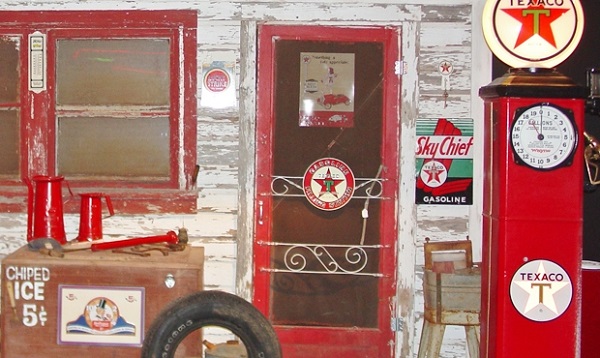
The National Route 66 Museum in Elk City, Oklahoma, preserves the heritage of Texaco, the first petroleum company to market products in all 50 states. Photo by Bruce Wells.
The Texas Company telegraph address at its New York office was “Texaco,” a name soon adopted for its petroleum products. In 1909 a red star with a green capital “T” was trademarked and by 1928 the Texaco brand operated more than 4,000 service stations nationwide. The Texas Company, which officially renamed itself Texaco in 1959, was acquired by Chevron in 2001.
Learn more in Sour Lake produces Texaco.

April 7, 1966 – Cold War Accident boosts Offshore Technology
A robotic technology soon adopted by the offshore petroleum industry was first used to retrieve an atomic bomb. America’s first cable-controlled underwater research vehicle (CURV) attached cables to recover the weapon lost in the Mediterranean Sea.
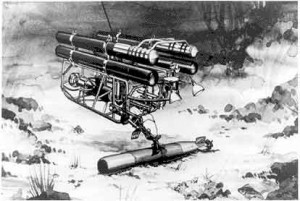
The U.S. Navy in 1966 used its CURV (Cable-Controlled Underwater Recovery Vehicle) to recover a lost nuclear bomb in the Mediterranean.
The 70-kiloton hydrogen bomb, which had been lost when a B-52 crashed off the coast of Spain in January, was safely hoisted from a depth of 2,850 feet.
“It was located and fished up by the most fabulous array of underwater machines ever assembled,” proclaimed Popular Science magazine. During the Cold War, the Navy developed deep-sea technologies that the offshore petroleum industry would adopt and continue to advance.
Learn more in ROV – Swimming Socket Wrench.
April 8, 1929 – Sinclair vs. United States
The Supreme Court unanimously upheld a lower court ruling that Congress had the right to investigate Sinclair Oil founder Harry Sinclair’s personal dealings with Secretary of the Interior Albert Fall regarding the leasing of federal oil reserves. In 1922, Fall had leased land in the Teapot Dome oilfield (Navy Reserve No. 3) to the Mammoth Oil Company, a Sinclair subsidiary. He also leased land in California’s Elk Hills reserve to Edward Doheny, the 1892 discoverer of the Los Angeles Field.
After several trials, proceedings concluded with Doheny being acquitted of conspiracy and Fall convicted of accepting bribes and serving nine months in prison, notes the Federal Judicial Center. He was the first cabinet official to go to prison. Sinclair was acquitted of conspiracy but convicted of contempt of Congress and served six and a half months in prison in 1929.
April 9, 1914 – Ohio Cities Gas Company founded
Beman Dawes and Fletcher Heath organized the Ohio Cities Gas Company in Columbus, Ohio, before building an oil refinery in West Virginia. Ohio Cities Gas acquired Pennsylvania-based Pure Oil Company in 1917 and adopted that name three years later. Pure Oil was founded in Pittsburgh in 1895 by independent oil producers, refiners, and pipeline operators to counter the market dominance of Standard Oil Company.
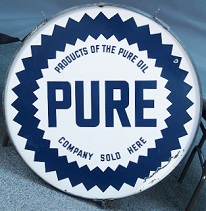
Ohio Cities Gas Company became Pure Oil in 1917.
By producing, refining and selling its products, Pure Oil became the second vertically integrated petroleum company after Standard Oil. Headquartered in a now iconic Chicago skyscraper it built in 1926, the company joined the 100 largest U.S. industrial corporations. It was acquired in 1965 by Union Oil Company of California, now a division of Chevron.
April 9, 1966 – Birthday of Tula’s Golden Driller
A 76-foot statue of an oilfield worker today known as “The Golden Driller” made its debut at the International Petroleum Exposition in Tulsa, Oklahoma. After several refurbishments, the 22-ton statue would contain 2.5 miles of rods and mesh with tons of plaster and concrete — withstanding winds up to 200 mph. A smaller version of Tulsa’s iconic roughneck originally appeared at the 1953 petroleum exposition as a promotion for the Mid-Continent Supply Company of Fort Worth, Texas.
April 10, 1866 – Densmore Brothers patent Railroad Oil Tank Car
James and Amos Densmore of Meadville, Pennsylvania, received a patent for their “Improved Car for Transporting Petroleum,” developed a year earlier in the northwestern Pennsylvania oil regions. Their patent illustrated a simple but sturdy design for securing two re-enforced containers on a typical railroad car.
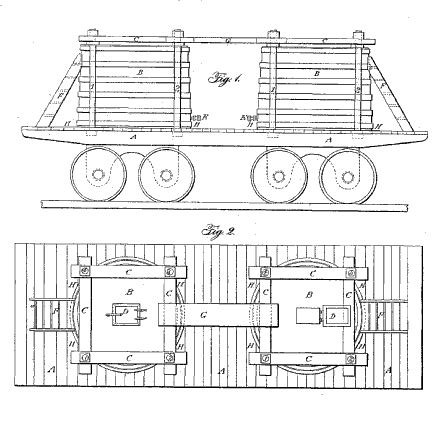
The Densmore dual tank car briefly revolutionized the bulk transportation of oil to market. Hundreds of the twin tank railroad cars were in use by 1866.
Although the Densmore cars were an improvement, they would be replaced by the more practical single, horizontal tank. After leaving the business, Amos Densmore in 1875 invented a new way for arranging “type writing machines” so commonly used letters would not collide — the “Q-W-E-R-T-Y” keyboard. James Densmore’s continued success in oilfields helped finance the start of the Densmore Typewriter Company.
Learn more in Densmore Brothers invent First Oil Tank Car.
April 11, 1957 – Independent Producer William Skelly dies
William Grove Skelly (1878 -1957) died in Tulsa after a long career as an independent producer he began as a 15-year-old tool dresser in early Pennsylvania oilfields. Prior to World War I, he found success in the El Dorado field outside Wichita, Kansas. Skelly incorporated Skelly Oil Company in Tulsa in 1919. In 1923, Skelly organized the first International Petroleum Exposition while serving as president of the Tulsa Chamber of Commerce. Skelly in 1947 helped establish KWGS, Tulsa’s first FM radio station and one of the earliest educational stations in the nation.

April 13, 1974 – Depth Record set in Oklahoma Anadarko Basin
After drilling for 504 days and spending about $7 million, the Bertha Rogers No. 1 well reached a total depth of 31,441 feet (5.95 miles) before being stopped by liquid sulfur. Drilled in Oklahoma’s Anadarko Basin, it held the record of the world’s deepest well for more than a decade.
The GHK Company of Robert Hefner III and partner Lone Star Producing Company believed natural gas reserves resided deep in the Anadarko Basin extending across West-Central Oklahoma and the Texas Panhandle. Their first high-tech drilling attempt began in 1967 and took two years to reach a then record depth of 24,473 feet.
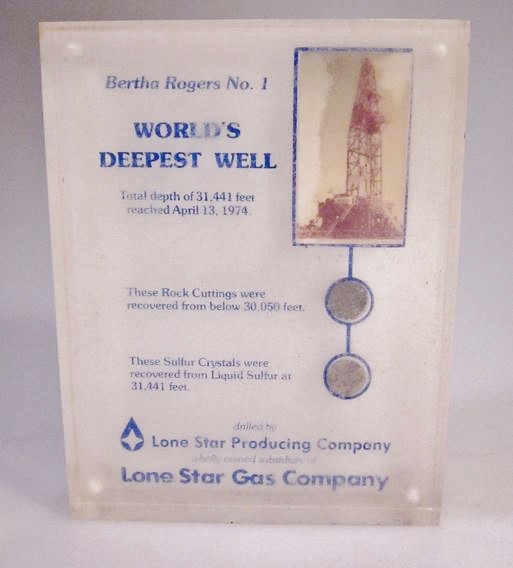
A 1974 souvenir plaque of the Bertha Rogers No. 1 well, which reached almost six miles deep in Oklahoma’s Anadarko Basin.
The 1969 well found plenty of natural gas, according to historian Robert Dorman, but because of federal price controls, “the sale of the gas could not cover the high cost of drilling so deeply – $6.5 million, as opposed to a few hundred thousand dollars for a conventional well.”
The drilling of the Bertha Rogers well began in November 1972 and averaged about 60 feet per day. By April 1974, bottom-hole pressure reached almost 25,000 pounds per square inch with a temperature of 475 degrees. The well’s 1.5 million pounds of casing was the heaviest ever handled by a drilling rig, and it took eight hours for cuttings to reach the surface.
Learn more in Anadarko Basin in Depth.
_______________________
Recommended Reading: The Texaco Story: The First Fifty Years, 1902-1952 (2012); Mapping the Deep: The Extraordinary Story of Ocean Science
(2012); Mapping the Deep: The Extraordinary Story of Ocean Science (2002); Diving & ROV: Commercial Diving offshore (2021); The American Railroad Freight Car (1995); Story of the Typewriter, 1873-1923 (2019); Tulsa Where the Streets Were Paved With Gold – Images of America
(2002); Diving & ROV: Commercial Diving offshore (2021); The American Railroad Freight Car (1995); Story of the Typewriter, 1873-1923 (2019); Tulsa Where the Streets Were Paved With Gold – Images of America (2000); Oil in Oklahoma
(2000); Oil in Oklahoma (1976); History Of Oil Well Drilling
(1976); History Of Oil Well Drilling (2007). Your Amazon purchase benefits the American Oil & Gas Historical Society. As an Amazon Associate, AOGHS earns a commission from qualifying purchases.
(2007). Your Amazon purchase benefits the American Oil & Gas Historical Society. As an Amazon Associate, AOGHS earns a commission from qualifying purchases.
_______________________
The American Oil & Gas Historical Society (AOGHS) preserves U.S. petroleum history. Please become an AOGHS annual supporter and help maintain this energy education website and expand historical research. For more information, contact bawells@aoghs.org. Copyright © 2025 Bruce A. Wells. All rights reserved.
by Bruce Wells | Jan 20, 2025 | This Week in Petroleum History
January 20, 1886 – Great Karg Well erupts Natural Gas in Ohio –
A well drilled for oil near Findlay, Ohio, erupted natural gas flowing at 12 million cubic feet per day from pressure that could not be controlled by technologies of the day. The “Great Karg Well” ignited into a flame that burned for four months and became a Findlay tourist attraction. Eight years earlier, a gas well in Pennsylvania had made similar headlines (see Natural Gas is King in Pittsburgh).

A plaque dedicated in 1937 at Findlay, Ohio, commemorated the state’s 1886 giant natural gas discovery.
Although Ohio’s first natural gas well was drilled in 1884 by the Findlay Natural Gas Company, the Karg well launched a gas-drilling boom that attracted manufacturing industries. Glass works companies were lured by the inexpensive gas (also see Indiana Natural Gas Boom), and new businesses included eight window glass factories, two bottle, two chimney lamp, one light bulb, one novelty, and five for tableware.
By 1887, Findlay was known as the “City of Light,” according to a historical marker erected in 1987 at the first field office of the Ohio Oil Company, which adopted the name Marathon Oil in 1962. The Hancock Historical Museum has preserved Great Karg Well history less than two miles from the well site.
January 21, 1865 – Testing the Roberts Torpedo
Civil War veteran Col. Edward A.L. Roberts (1829-1881) conducted his first experiment to increase oil production by using an explosive charge deep in the well. Roberts twice detonated eight pounds of black powder 465 feet deep in the bore of the “Ladies Well” on Watson’s Flats south of Titusville, Pennsylvania.

Civil War veteran Col. E.A.L. Roberts demonstrated his oil well “torpedo” south of Titusville, Pennsylvania.
The “shooting” of the well was a success, increasing daily production from a few barrels of oil to more than 40 barrels, according to Pennsylvania Heritage Magazine. By 1870, Roberts’ torpedoes using nitroglycerin became common in oilfields.
In April 1865, Roberts received the first of many patents for his “exploding torpedo,” and one year later the Titusville Morning Herald reported, “Our attention has been called to a series of experiments that have been made in the wells of various localities by Col. Roberts, with his newly patented torpedo. The results have in many cases been astonishing.”

January 22, 1861 – Pennsylvania Stills produce Kerosene
The first U.S. multiple-still oil refinery was brought on-stream one mile south of Titusville, Pennsylvania, by William Barnsdall, who had drilled the second successful well after Edwin Drake’s first U.S. oil discovery. Barnsdall and partners James Parker and W.H. Abbott spent about $15,000 to build six stills for refining kerosene. Equipment was purchased in Pittsburgh and shipped up the Allegheny River to Oil City where a refinery produced two grades of kerosene, white and the less expensive yellow.
January 22, 1910 – Standard Oil of California strikes Oil
Standard Oil Company of California (Socal) drilled its first successful oil well, a gusher in Kern County that initially produced 1,500 barrels of oil a day from the Midway-Sunset field. The discovery came after the 1906 merger of Pacific Coast Oil Company (see First California Oil Well) and Standard Oil Company of Iowa to create Socal.
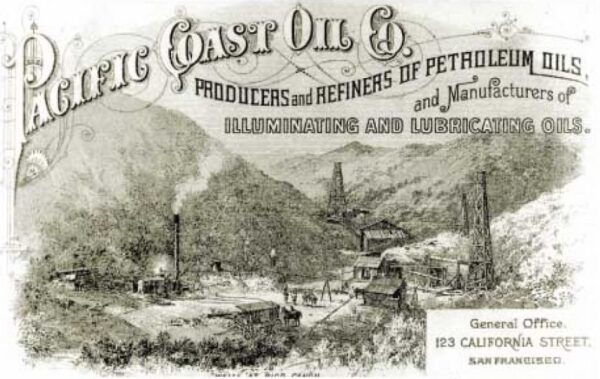
Standard Oil Company of California (Socal) began in 1879 as the Pacific Coast Oil Company and was renamed Chevron in 1981. Image courtesy Chevron.
The new company needed more oil reserves after it had “stepped up its marketing efforts, particularly in gasoline sales, which nearly doubled between 1906 and 1910,” according to a company history. “Until now, Standard had left the hunt for oil to others.”
The U.S. Supreme Court in 1911 ordered Socal separated from its parent, Standard Oil Company of New Jersey. After absorbing Standard Oil of Kansas in 1961 and making other acquisitions, the California company in 1984 rebranded as Chevron, headquartered in San Ramon.

January 23, 1895 – Standard Oil closes Oil Exchanges
Standard Oil Company of New Jersey’s purchasing agency in Oil City, Pennsylvania, notified independent oil producers it would only buy their oil at a price “as high as the markets of the world will justify” — and not “the price bid on the oil exchange for certificate oil.”
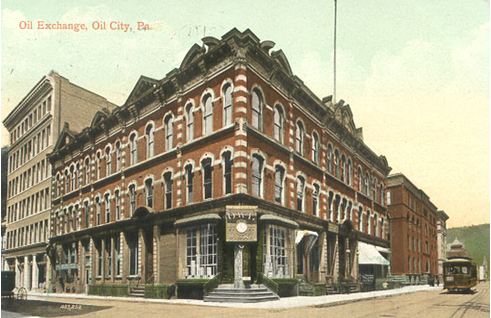
The Oil City, Pennsylvania, Oil Exchange was incorporated in 1874. Three years later, it was the third-largest U.S. financial exchange.
Oil City’s exchange had become the third largest financial exchange of any kind in America, behind New York and San Francisco. But with the Standard Oil Company buying 90 percent of oil production and setting its own price for certificates, all other oil exchanges soon closed.
Learn more in End of Oil Exchanges.
January 23, 1957 – Wham-O launches a New Petroleum Product
Among the earliest mass-produced products made from plastic, the “Frisbee” was introduced by Wham-O Manufacturing Company of California. The polymer toy originated in 1948 when a company called Partners in Plastic sold its “Flyin’ Saucers” for 25 cents each. In 1955, Richard Knerr and Arthur “Spud” Melin’s Wham-O bought the rights.
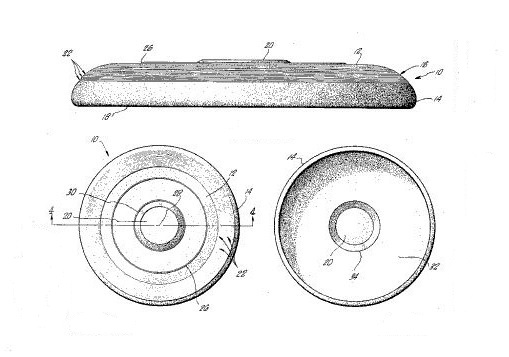
U.S. patent with mold details of a 1967 polyethylene plastic Frisbee.
The Wham-O founders discovered that Phillips Petroleum had invented a high-density polyethylene (called Marlex). They used the new plastic to meet phenomenal demand for manufacturing Frisbees – and Hula Hoops beginning in 1958.
Learn more in Petroleum Product Hoopla.
January 23, 1991 – Gulf War brings World’s Largest Oil Spill
The world’s largest oil spill began in the Persian Gulf when Saddam Hussein’s retreating Iraqi forces opened pipeline valves at oil terminals in Kuwait. About 11 million barrels of oil would cover an area extending 101 miles by 42 miles and reaching five inches thick in some places.
Iraqi soldiers sabotaged Kuwait’s main supertanker loading pier, dumping millions of gallons of oil into the Persian Gulf. By February, about 600 Kuwaiti wells had been set ablaze. It would take months to put out the well fires, with the last extinguished in early April (also see Oilfield Firefighting Technologies).

January 24, 1895 – Independent Producers found Pure Oil
To counter Standard Oil Company’s market dominance, Pennsylvania oil producers, refiners, and pipeline operators organized what would become a major Chicago-based oil venture. Originally based in Pittsburgh, Pure Oil Company quickly grew into the second vertically integrated U.S. petroleum company after Standard Oil.

Ohio Cities Gas acquired Pure Oil in 1920 and kept the popular Pennsylvania brand name.
Beginning in early 1896, Pure Oil marketed its petroleum products by horse-drawn tank wagons in Philadelphia and New York — successfully competing with Standard Oil’s monopoly. The Ohio Cities Gas Company of Columbus acquired Pure Oil and in 1920 adopted the former Pennsylvania venture’s brand name.
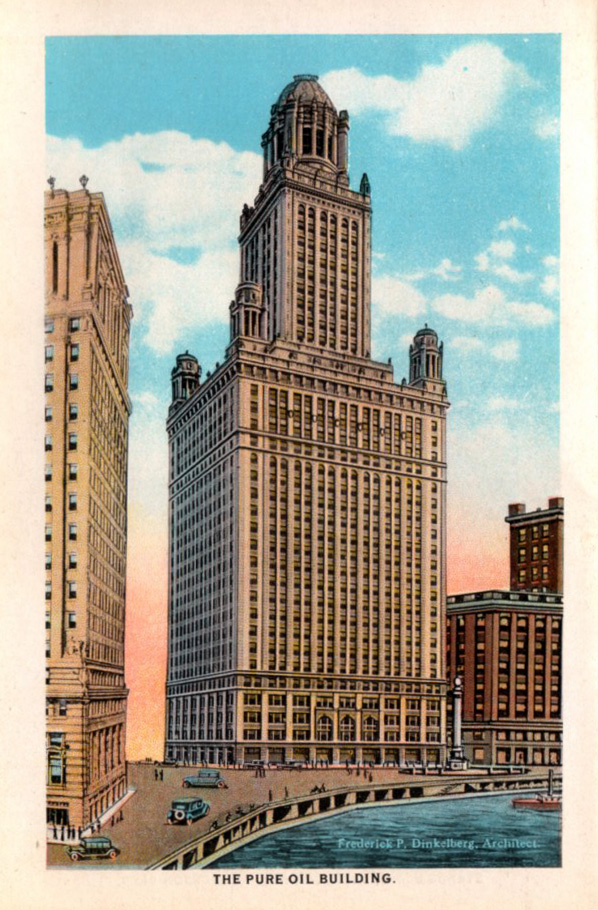
Pure Oil Company moved into its newly built 40-story Chicago headquarters on East Wacker Drive in 1926.
With a new Chicago headquarters opened in 1926, Pure Oil began exploring offshore technologies within a decade. The company developed early freestanding drilling platforms in the Gulf of Mexico.
January 25, 1930 – North Texas Oil Producers form Association
After meeting in Wichita Falls to protest “the recent drastic price cut in crude oil, inaugurated by some of the major purchasing companies,” 50 independent producers organized the North Texas Oil and Gas Association. Other issues included seeking a tariff on foreign oil imports and stopping “hot oil” oilfield thefts. The association merged with the West Central Texas Oil & Gas Association in 1998 to become the Texas Alliance of Energy Producers.

January 26, 1931 – Third Well reveals Extent of East Texas Oilfield
As East Texas farmers struggled to survive the Great Depression, an oil discovery confirmed the existence of a massive oilfield. W.A. “Monty” Moncrief of Fort Worth completed the Lathrop No. 1 well, which produced 7,680 barrels of oil a day from 3,587 feet deep. Geologists at first thought a third oilfield had been found.
Moncrief’s discovery well was 25 miles north of the famous Daisy Bradford No. 3 well of October 1930, drilled by Columbus Marion “Dad” Joiner. It was 15 miles north of the Lou Della Crim No. 1 well, completed at Kilgore three days after Christmas 1930. The 130,000-acre East Texas oilfield would become the largest in the lower 48 states.
Learn more in Moncrief makes East Texas History.
_______________________
Recommended Reading: Myth, Legend, Reality: Edwin Laurentine Drake and the Early Oil Industry (2009); Portrait in Oil: How Ohio Oil Company Grew to Become Marathon
(2009); Portrait in Oil: How Ohio Oil Company Grew to Become Marathon (1962); Ohio Oil and Gas, Images of America
(1962); Ohio Oil and Gas, Images of America (2008); Trek of the Oil Finders: A History of Exploration for Petroleum (1975). Titan: The Life of John D. Rockefeller, Sr.
(2008); Trek of the Oil Finders: A History of Exploration for Petroleum (1975). Titan: The Life of John D. Rockefeller, Sr. (2004); Plastic: The Making of a Synthetic Century
(2004); Plastic: The Making of a Synthetic Century (1996); Against the Fires of Hell: The Environmental Disaster of the Gulf War
(1996); Against the Fires of Hell: The Environmental Disaster of the Gulf War (1992); The Black Giant: A History of the East Texas Oil Field and Oil Industry Skulduggery & Trivia
(1992); The Black Giant: A History of the East Texas Oil Field and Oil Industry Skulduggery & Trivia (2003). Your Amazon purchase benefits the American Oil & Gas Historical Society. As an Amazon Associate, AOGHS earns a commission from qualifying purchases.
(2003). Your Amazon purchase benefits the American Oil & Gas Historical Society. As an Amazon Associate, AOGHS earns a commission from qualifying purchases.
_______________________
The American Oil & Gas Historical Society (AOGHS) preserves U.S. petroleum history. Become an AOGHS annual supporting member and help maintain this energy education website and expand historical research. For more information, contact bawells@aoghs.org. Copyright © 2025 Bruce A. Wells. All rights reserved.




(2012); Mapping the Deep: The Extraordinary Story of Ocean Science
(2002); Diving & ROV: Commercial Diving offshore (2021); The American Railroad Freight Car (1995); Story of the Typewriter, 1873-1923 (2019); Tulsa Where the Streets Were Paved With Gold – Images of America
(2000); Oil in Oklahoma
(1976); History Of Oil Well Drilling
(2007). Your Amazon purchase benefits the American Oil & Gas Historical Society. As an Amazon Associate, AOGHS earns a commission from qualifying purchases.










